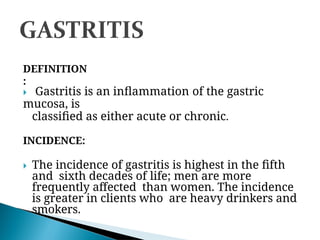7.Gastritis.pptx,,,,,,,,,,,,,,,,,,,,,,,,
- 1. Gastritis
- 2. DEFINITION : ’üĮ Gastritis is an inflammation of the gastric mucosa, is classified as either acute or chronic. INCIDENCE: ’üĮ The incidence of gastritis is highest in the fifth and sixth decades of life; men are more frequently affected than women. The incidence is greater in clients who are heavy drinkers and smokers.
- 3. ’üČETIOLOGY AND RISK FACTORS: ’üĮ It usually stems from ingestion of a corrosive, erosive, or infectious substance. ’üĮ Aspirin and other non-steroidal anti-inflammatory drugs (NSAIDs), digitalis, chemotherapeutic drugs, steroids, acute alcoholism and food poisoning (typically caused by Staphylococcus organisms) are common causes. ’üĮ Food substances including excessive amounts of tea, paprika, clove and pepper can precipitate acute gastritis. ’üĮ Foods with a rough texture or those eaten at an extremely high temperature can also damage the stomach
- 4. ’üĮ The mucosal lining of the stomach normally protects it from the action of gastric acid. This mucosal barrier is composed of prostaglandins. Due to any cause Ōåō This barrier is penetrated Ōåō Hydrochloric acid comes into contact with the mucosa Ōåō Injury to small vessels Ōåō Edema, hemorrhage, and possible ulcer
- 5. ’āś Epigastric discomfort ’āś Abdominal tenderness ’āś Cramping ’āś Belching ’āś Reflux ’āś Severe nausea and vomiting ’āś Hematemesis ’āś Sometimes GI bleeding is the only manifestation ’āś When contaminated food is the cause of gastritis, diarrhea usually develops within 5 hours of
- 6. ’āśDiagnosis is based on a detailed history of food intake, medications taken, and any disorder related to gastritis. ’āśThe physician may also perform a gastroscopic examination with endoscopy. ’āśHistological examination by biopsy of a
- 7. 10 Diagnoses Tests that may be needed are: Complete blood count (CBC) to check for anemia or low blood count Examination of the stomach with an endoscope (esophagogastroduodenoscopy or EGD/OGD)
- 8. 11 Diagnoses 1.H. pylori Stool antigen test ŌĆō Stool more sensitive than blood test 2.Stool test For occult blood check for small amounts of blood in the stools, which may be a sign of bleeding in the stomach due to gastric erosion
- 9. ’āś Anti ŌĆō emetic drugs like Inj. Perinorm or Tab. Domperidone are frequently effective in vomiting. ’āś PPIS. e.g omeprazole , lansoprazole . Esomeprazole ’āś H2 Receptor antagonist eg.cimetidine, Ranitidine, or Famotidine are effective to reduce the pain. ’āś If ingestion of NSAIDs is a problem, a prostaglandin E1 (PGE1) analog may be prescribed to protect the stomach mucosa and inhibit gastric acid secretion.
- 10. ’āś Initially foods and fluids are withheld until nausea and vomiting subside. ’āś Once the client tolerates food, the diet includes decaffeinated tea, gelatin, toast, and simple bland foods. ’āś The client should avoid spicy foods, caffeine and large, heavy meals. ’āś In the continued absence of nausea, vomiting and bloating, the client can slowly return to a normal diet.
- 11. ’üĮ Chronic gastritis occurs in 3 different forms 1) Superficial gastritis, which causes a reddened, edematous mucosa with small erosions and hemorrhages. 2) Atrophic gastritis, which occurs in all layers of the stomach, develops frequently in association with gastric ulcer and gastric cancer, and is invariably present in pernicious anemia; it is characterized by a decreased number of parietal and chief cells. 3) Hypertrophic gastritis, which produces a dull and nodular mucosa with irregular, thickened, or nodular rugae; hemorrhages occur frequently.
- 12. ’ü▒Peptic Ulcer Disease (PUD), infection with Helicobacter pylori bacteria or gastric surgery may lead to chronic gastritis. ’ü▒ After gastric resection with a gastro- jejunostomy, bile and bile acids may reflux into the remaining stomach, causing gastritis. ’ü▒ H.Pylori infection can lead to chronic atrophic gastritis. ’ü▒ Age is also a risk factor; chronic gastritis
- 13. The stomach lining first becomes thickened and erythematous and then becomes thin and atrophic. Ōåō Continued deterioration and atrophy Ōåō Loss of function of the parietal cells Ōåō Acid secretion decreases Ōåō Inability to absorb vitamin B12 Ōåō Development of pernicious anemia
- 14. Manifestations are vague and may be absent because the problem does not cause an increase in hydrochloric acid. Assessment may reveal ’āś Anorexia ’āś Feeling of fullness ’āś Dyspepsia ’āś Belching ’āś Vague epigastric pain ’āś Nausea ’āś Vomiting ’āś Intolerance of spicy and fatty foods
- 15. ’é¦ Bleeding ’é¦ Anemia ’é¦ Chronic atrophic gastritis ’é¦ Gastric cancer















